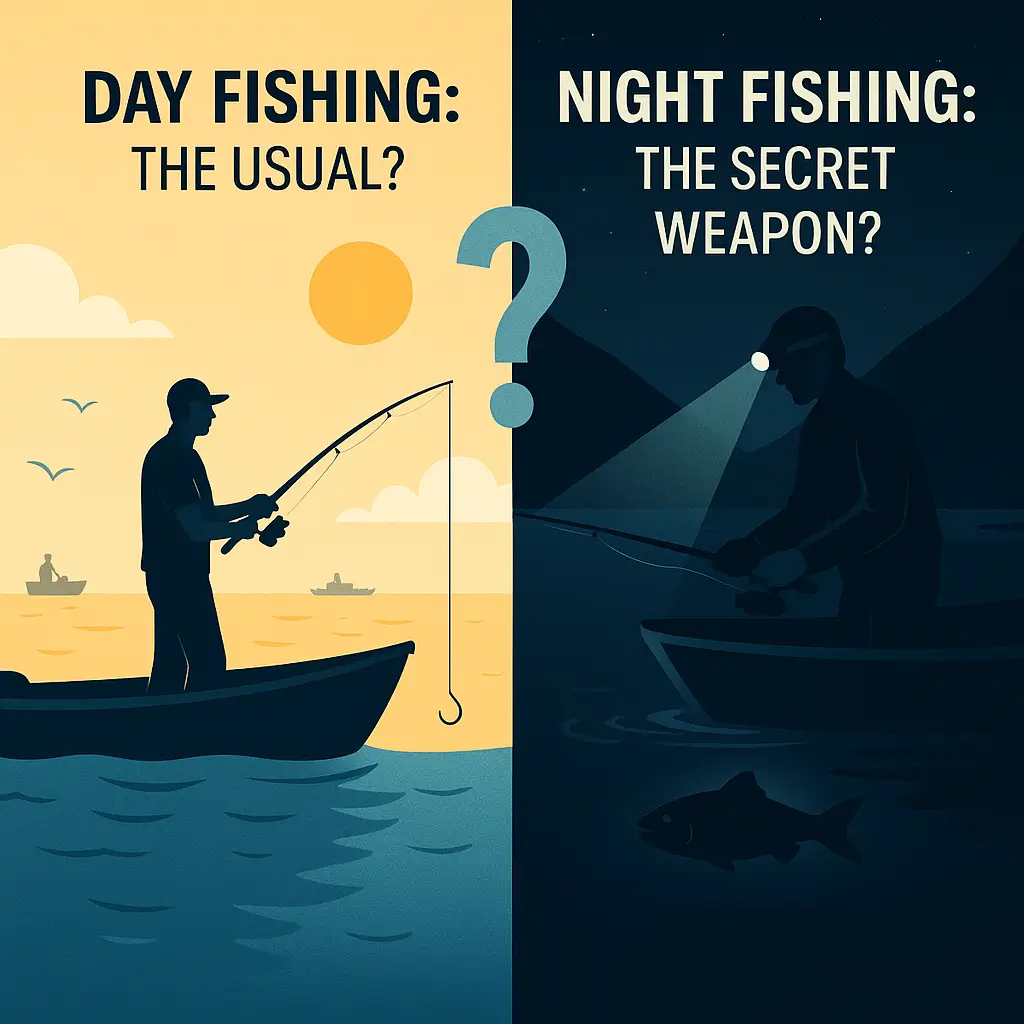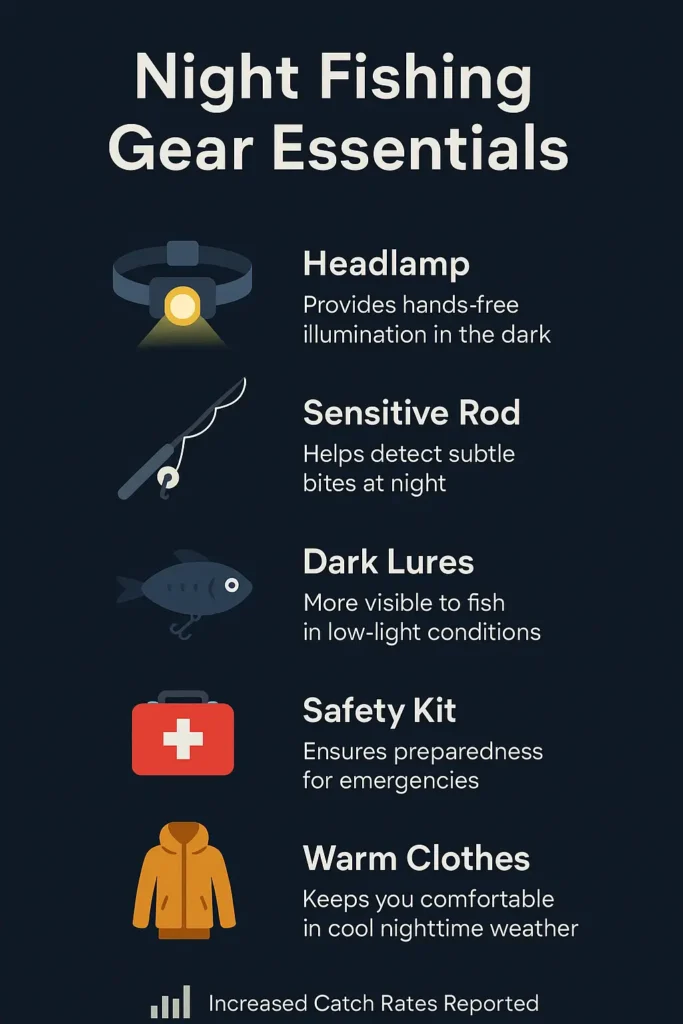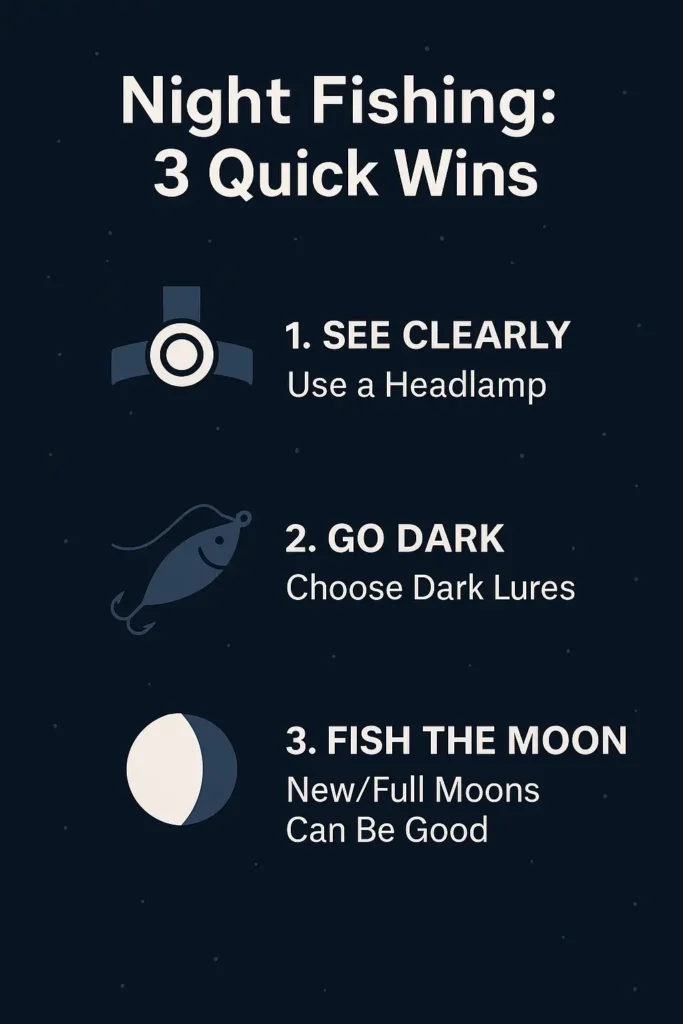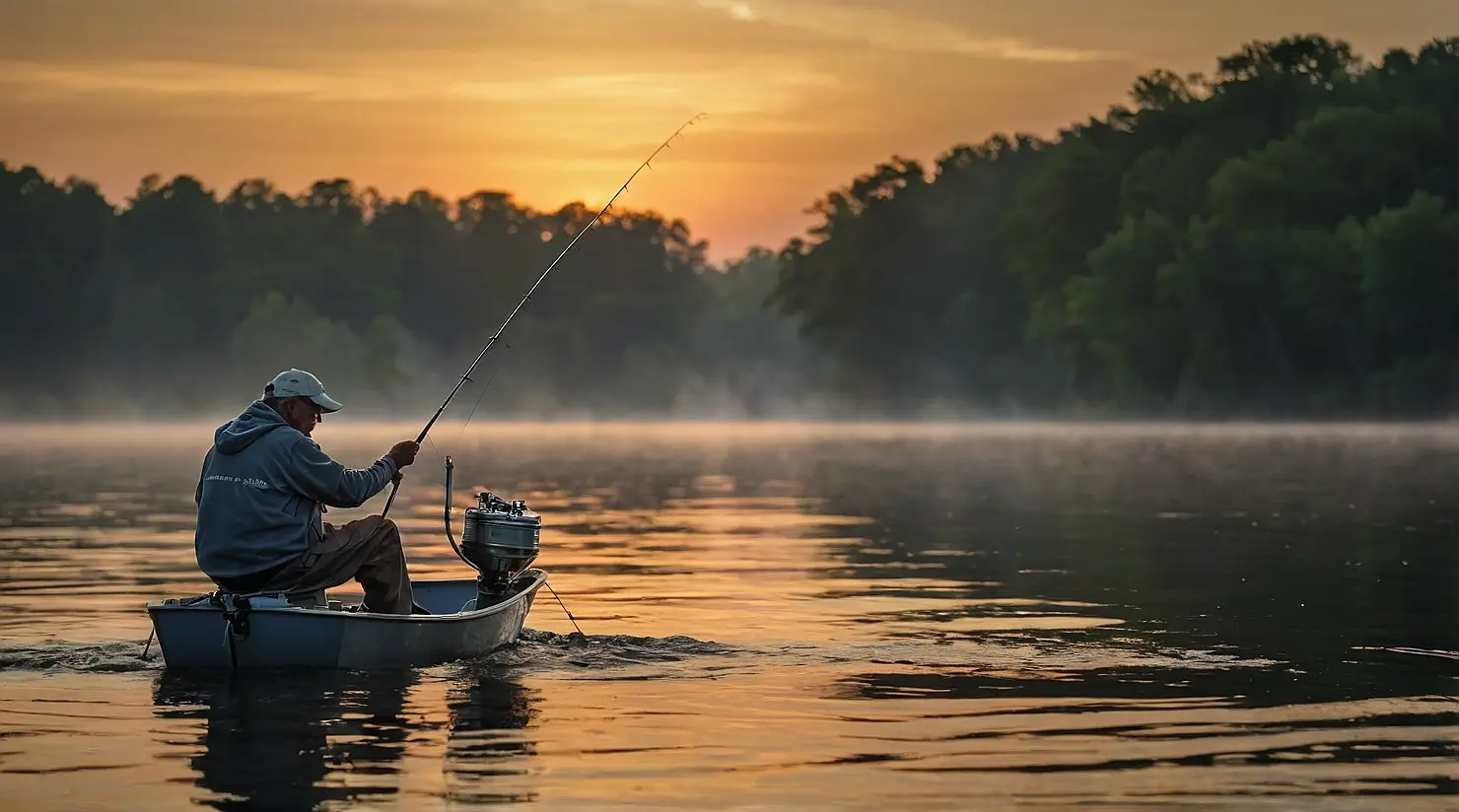Day fishing often delivers small returns. The best bites hit when the sun drops. Night fishing in Canada gives you calm water and active fish.
This guide shares the exact strategies to land more fish, even in the dark. You get clear, actionable advice to fill your cooler.
Night Fishing Techniques — Summary
Quick picks
Top‑10 Night Fishing Tips
- Stealth & sound: Move slowly, avoid banging hull/rocks; sound travels farther at night.
- Light discipline: Keep lights low and red/green where possible; avoid blasting the water.
- Silhouette baits: Use dark/contrasty lures (black, blue, purple) that throw a strong outline.
- Vibration & noise: Choose thumping blades, rattling plugs, curly tails; let fish find you.
- Slow it down: Retrieve slower with pauses; bump structure and current seams.
- Fish the edges: Lights lines, dock/bridge shadows, weedlines, rip‑rap, points.
- Time windows: Dusk, tide swings, moonrise/set often trigger 20–40‑min bites.
- Moon & tide: Plan around moving water; overcast nights = darker = stronger silhouettes.
- Safety first: PFD, kill‑switch, spare light/batteries, reflectives, tell someone your plan.
- Bug & temp plan: Repellent, buff/hood, hydration; cooler air can chill quickly.
Tip: Pre‑rig 3–4 rods with different depths/noise profiles to rotate fast.
Why Night Fishing Offers Unique Opportunities
Night fishing changes the game.
When the sun sets, the water cools. This brings baitfish into shallower areas. Larger predatory fish follow. You find less boat traffic, fewer people.
The water is calmer, quieter. This environment benefits you. Fish lose their daytime caution. They move more freely, feed more aggressively.

Think about it. During the day, bright sun pushes many species deeper. Light makes them wary. At night, that pressure lifts. Bass move shallow. Walleye actively hunt. Catfish roam the bottom.
These nocturnal hunters rule the dark water fishing scene. This shift offers a massive advantage to the prepared angler. You get access to fish that are harder to reach during daylight hours. Less competition means your lines see more action.
This is not just about catching fish; it’s about catching more fish, and often bigger fish. The stillness of the night also provides a unique, peaceful experience, far from crowded shores. You hear the sounds of nature, feel the subtle tugs. It’s a different world.
A world where your chances for a massive catch go way up. These unique conditions make night fishing a must-try for any serious angler in Canada. Many find their biggest catches happen under the moon.
- Less human activity means quieter waters.
- Fish move into shallower feeding grounds.
- Nocturnal predators become highly active.
- Cooler water temperatures keep fish comfortable.
Essential Night Fishing Gear & Equipment
Success after dark demands the right night fishing gear.
You cannot rely on your daytime setup. Visibility is low. Fish behave differently. Your night fishing setup must reflect this.

First, lighting. A reliable Headlamp is crucial. It keeps your hands free. Always carry a backup Flashlight too. Brighter, wider beam lights help with casting or unhooking.
Submersible LED lights are game-changers. They draw plankton, then baitfish, which attracts larger predatory fish. You want quality, waterproof lights. For your rod tips or bobbers, Glow sticks make bites visible.
Next, your main equipment: rod, reel, and fishing line. You need sensitivity. A medium-heavy rod with a fast action helps you feel subtle bites.
Pair it with a smooth, durable reel. Check out the best fishing reels for Canada for solid options.
For fishing line, consider a high-visibility monofilament or fluorocarbon. Some anglers prefer braided line for strength and sensitivity, but it can be hard to see. For bait, think scent and vibration.
Glow in the dark lures are effective. Scented soft plastics or natural bait like worms and cut bait work well. Fish rely on smell and vibration in the dark. Live bait, like minnows or leeches, is often irresistible. Safety gear is paramount.
A first aid kit, extra batteries, a whistle, and a fully charged phone are non-negotiables. A portable power station, like those from Ecoflow.com, ensures your lights and communication stay powered.
- Powerful, hands-free Headlamp for tying knots and baiting hooks.
- Submersible LED lights to attract baitfish and predators.
- Sensitive rods and strong fishing line to detect subtle bites.
- Glow in the dark lures and strong-scented baits for visibility and appeal.
- Essential safety items: first aid, backup lights, communication device.
Essential Night Fishing Gear
Prioritizing Safety During Your Night Fishing Trip
Your night fishing trip must start with safety. The dark hides many dangers. A familiar spot in daylight becomes a hazard at night. Before you go, scout your chosen location.
Note obstacles, sharp drops, or slippery areas.
Use a GPS device to mark safe paths and key fishing spots. Do not rely solely on your memory. Nightfishing.ca highlights the importance of being aware of your surroundings.

Never fish alone after dark. Use a buddy system. Someone should always know your exact location and expected return time. A fully charged cell phone is a minimum for communication. Consider a marine radio or satellite communicator for remote areas.
Even small sounds carry far in the quiet of the night, so be mindful of your voice. This also helps with stealth when approaching fish. Weather conditions change fast in Canada.
Check the forecast before you leave. Be ready for sudden drops in temperature, rain, or wind. Pack extra layers of warm clothing, even on mild evenings. A good set of rain gear is always wise.
An emergency preparedness kit should include a space blanket, fire starter, knife, and extra food and water. Accidents happen. You cannot rely on others finding you in the dark.
Taking these night fishing safety tips seriously keeps you safe, allowing you to focus on the catch. Always make your return home your biggest priority.
- Scout your fishing spot in daylight; mark hazards with GPS.
- Never fish alone; inform someone of your plans and expected return.
- Carry communication devices and a comprehensive emergency kit.
- Monitor weather constantly and prepare for rapid changes.
- Bring proper clothing layers to stay warm and dry in the dark.
The 7 Proven Night Fishing Techniques Explained
To consistently catch fish after dark, you need specific night angling strategies. These techniques go beyond just casting a line. You adapt to the night environment.
1. Utilizing Artificial Light to Attract Fish
Artificial light draws plankton. Plankton draws baitfish.
Baitfish draw predators. Use submersible LED lights. Green or white light works best. Position them in the water to create a glow. This forms a feeding zone. Fish, like Crappie and Walleye, gather here. Keep the lights on steady.
2. Understanding Moon Phases and Their Impact
The Moon phase affects fish activity. A full moon means more light, making fish cautious. New moon phases offer true darkness. This is often when fish are most bold and active. They rely on their low-light vision and other senses. Adapt your approach based on the moonlight. On bright nights, fish deeper. On dark nights, work shallower areas.
3. Focusing on Structure and Drop-Offs
Fish relate to structure. This holds true at night.
Submerged timber, rock piles, weed lines, and sharp drop-offs are key spots. Use a Sonar unit if on a boat to locate these features. Fish use these areas for ambush points. Cast your lure or bait precisely around these structures. In dark water fishing, fish won’t chase far.
4. Slow and Steady Retrieval Methods
Fish are less active and slower to react in the dark.
Your retrieval needs to match this. Use a slow, deliberate retrieve for your lure or bait. This gives fish more time to locate it by vibration and scent. Sometimes, a dead-stick retrieve (letting the lure sit motionless) triggers a strike. Think subtle.
5. Using Scented Baits and Soft Plastics
Fish rely heavily on smell and touch at night.
Use scented baits or add scent to your lure. Soft plastic baits infused with attractants are highly effective. Natural baits like worms, cut bait, or live minnows also work well. The scent trail guides fish to your hook in the low light.
6. Targeting Predatory Fish Near Shorelines
Many predatory species, including Bass and Walleye, move into shallow shorelines at night to hunt.
They ambush baitfish. Cast parallel to the bank. Look for areas with cover: fallen trees, docks, or rocky points. These shallow water areas can be highly productive for night fishing for bass and Walleye.
7. Employing Sound and Vibrations to Attract Bites
Sound travels well in water.
Use lures that create vibration or rattles. Spinnerbaits, chatterbaits, or rattling crankbaits can call fish in from a distance.
A slow, steady retrieve still applies. The sound helps fish pinpoint your lure in the dark.
| Technique | Best for Species | Key Gear & Conditions |
|---|---|---|
| Artificial Light | Walleye, Crappie, Catfish | Submersible LED lights, Calm nights |
| Slow Retrieval | All Species | Scented soft plastics, Live bait |
| Focus on Structure | Bass, Walleye, Perch | Sonar, Precise casting, Any moon phase |
Best Fish Species to Target at Night
Certain species thrive in the dark. They become your prime targets for night fishing in Canada. Knowing what fish bite at night increases your success.
Walleye: Masters of the Night Walleye possess superior low-light vision.
Their large, light-sensitive eyes make them incredibly effective predators after sunset. They move from deep holes to shallow feeding flats and rocky points.
Targeting Walleye at night is highly productive. Use crankbaits, jigs, or live minnows near structure. For specific strategies, look into Walleye fishing techniques. They are a top choice for a reason.
Catfish: Bottom Dwellers After Dark Catfish rely on their keen sense of smell and touch. Light conditions do not affect them negatively.
They are bottom feeders and become very active after dark, cruising for food. Use strong-scented baits like cut bait, chicken livers, or dough balls. Fish them on the bottom using a slip-sinker rig. Their powerful pulls make for an exciting fight. They are a reliable species for night anglers.
Bass: Ambush Predators in Low Light Both Largemouth and Smallmouth Bass become ambush predators at night. They move into shallow cover to hunt baitfish.
Night fishing for Bass demands stealth. Use topwater lures that create a disturbance (buzzbaits, poppers) or dark-colored spinnerbaits and jigs. Cast close to docks, weed lines, and fallen trees. They will strike hard. The surprise of a Bass hitting your lure in the dark is exhilarating.
Other species like Crappie and Perch also bite well at night, especially when attracted by lights. They offer consistent action. Focus on these fish to fill your cooler.
- Walleye hunt aggressively in low light due to excellent vision.
- Catfish rely on smell, making them active night feeders.
- Bass move shallow, ambushing prey in the dark.
- Crappie and Perch also provide good action with artificial lights.
Advanced Tips for Maximizing Your Night Fishing Success
You want every edge you can get. These advanced night fishing tips push your success even higher. They separate the casual angler from the consistent catcher.
Stealth and Minimizing Noise
Fish are sensitive to vibrations and noise, especially at night. Keep talking to a minimum. Step lightly on the bank or boat. Avoid banging tackle boxes or dropping gear. Use minimal light. A red filter on your Headlamp preserves your night vision and is less likely to spook fish. Avoid shining bright lights directly on the water you are fishing. Your goal is to blend into the darkness, not break it.
Preparing Your Spot in Advance
A successful night fishing trip starts long before dark. Scout your location during daylight. Identify key structures, potential hazards, and easy access points. Organize all your equipment. Rig multiple rods with different lures or baits. Lay out your night fishing gear so you can find everything by feel.
Set up your fishing tents and shelters before the sun goes down if you plan to stay overnight. This preparation saves time and reduces fumbling in the dark, which also minimizes noise. Canadian lodges, like those found at LawrenceBay.com, often stress this pre-trip readiness for maximum results.
Patience and Persistence
Night fishing demands patience. Bites can be subtle. Sometimes fish take time to move into their feeding patterns. Do not pack up after an hour of no bites. Adjust your techniques: try different lures, depths, or retrieval speeds.
Stay persistent.
The biggest fish often bite when you least expect it, or after hours of waiting. The reward for your persistence can be a truly massive catch, a fish you wouldn’t have hooked during the day. Remember, the peace of the night is part of the experience.
- Minimize noise and light to avoid spooking fish in the dark.
- Pre-rig rods and organize all equipment during daylight hours.
- Practice patience; bites can be subtle and require waiting.
- Adapt your techniques if initial efforts yield no results.
- Scout Ahead: Know your fishing spot. Visit during the day to see where fish might hide.
- Go Slow: Fish often prefer slower lure movements at night. Don’t rush your retrieve.
- Listen Up: Pay attention to sounds. Splashes can signal fish activity near you.
Conclusion: Embrace the Darkness for Unforgettable Catches
Night fishing is a powerful way to catch more fish. You beat the crowds. You tap into the active feeding patterns of nocturnal species. With the right night fishing gear, a focus on safety, and proven techniques, you stand to land a truly massive catch.
The stillness of the dark offers a unique, rewarding experience. It’s a different world out there, waiting for the prepared angler. Your next big fish is waiting in the dark water fishing spots. Embrace it.
Expert Insights
After over a decade of chasing fish under the stars, one thing became crystal clear to me: your biggest mistake is usually your light. I remember my first few years. I’d have my big, bright Flashlight or a powerful Headlamp on, thinking I needed to see everything.
Wrong.
The fish see that light. And they run from it. My biggest breakthrough came when I started using minimal, directed light. Just enough for tying a knot or baiting a hook, then off.
Submersible LED lights are different; they draw plankton, which draws baitfish, which attracts predators.
But bright overheads?
They spook everything within a 50-foot radius. Also, never skimp on a good fishing line. In the dark, you can’t see fray or small snags.
That’s a lost fish and a broken heart right there. Always check your setup before you cast. That one tip alone saved me countless fish and a lot of frustration when fishing after dark.
Conclusion & Next Steps
Night fishing unlocks incredible opportunities. You get calmer waters, less competition, and often bigger fish. Get your gear ready, prioritize safety, and master these techniques.
You will catch more fish. Get your fishing license in Canada and hit the water tonight.
Frequently Asked Questions About Night Fishing in Canada
What is the best bait for night fishing in Canada?
The ideal bait varies by fish species. For Walleye, live minnows or jigs with soft plastics are effective. Catfish prefer strong-scented options like cut bait or chicken livers. When targeting Bass, dark-colored topwater lures or spinnerbaits work well. Scent is a crucial factor in the dark, so always align your bait choice with your target fish’s diet and sensory strengths.
Can fish detect fishing line at night?
While a fish's vision is diminished at night, they can still perceive shadows and movement. Some fishing lines are more visible than others. Many anglers opt for a heavier fluorocarbon leader, which tends to be less visible in dark water. The primary goal is to present your lure or bait naturally, regardless of how well the fish can see your line.
Is night fishing more dangerous than day fishing?
Yes, night fishing inherently carries more risks. Low visibility makes navigation challenging and increases the likelihood of falls or injuries. Temperatures can drop rapidly, and wildlife activity is often heightened. Always prioritize safety by bringing ample lighting, fishing with a buddy, informing others of your plans, and preparing for potential emergencies.
Do I need a special fishing license for night fishing in Canada?
No, a standard Canadian fishing license covers night fishing. However, it is essential to always comply with provincial or territorial regulations. You must check the specific rules for the waters you plan to fish, including catch limits and open seasons. Information on how to obtain a fishing license in Canada is readily available to ensure you are compliant.




